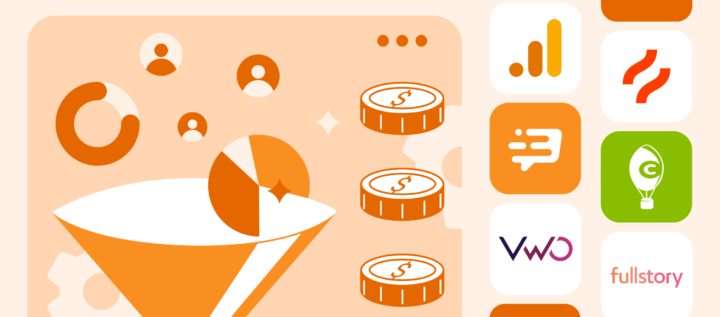The best way to collect emails: 5 top-notch methods unveiled
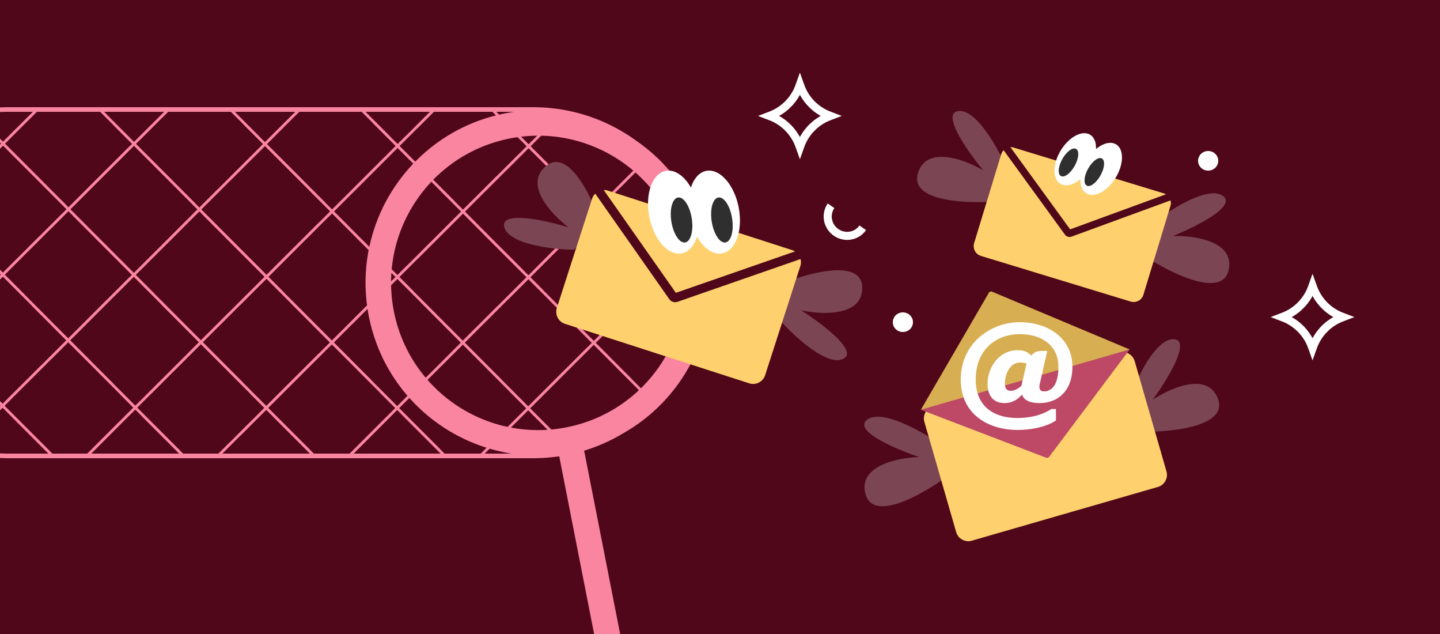
In the bustling digital marketplace, a robust email list can be your golden ticket to heightened business performance and user engagement. If you’ve been racking your brains over the best way to collect emails on your website effectively, then you’ve landed in the right place.
In today’s article, we cut through the clutter to present you with the finest, most efficient techniques in the email collection landscape. We’ve tested and assiduously researched the ‘best online way to collect email’ from your website. From uncomplicated sidebar forms to compelling exit-intent popups, we’ll dive into each technique’s mechanics, advantages, and potential caveats.
Get ready to level up your marketing strategy as we embark on a journey to decode the five best ways to collect emails from your website visitors. Whether you are a seasoned campaigner or a novice dipping your toes in the vast ocean of digital marketing, this comprehensive guide will arm you with proven strategies and innovative insights to bolster your email list like never before.
Let’s dive in, shall we?
Lead magnets for capturing emails
Alright, let’s dive into our first tactic — the powerful lead magnets! 🧲
Lead magnets are the bread and butter of email collection strategies. They are an incredibly effective tool and often considered the best way to collect email leads. But what makes them so great? The secret lies in the value they provide.
The essence of a lead magnet is offering your prospects something truly useful for free in exchange for their email address. This could be an eBook, a free sample, or even a fun quiz. By doing this, you’re not just capturing addresses, you’re building relationships and trust with prospective customers.
Why is sharing free content so important?
Well, think about it. Would you be more likely to give your email to someone who’s offering you helpful, interesting, and free content, or to someone who’s simply asking for it with no incentive? Most people would choose the former.
This is the power of lead magnets.
They make the process of address capture less intrusive and more beneficial for your prospects, which in turn increases the likelihood of them sharing their information.
Okay, so we’ve got these fantastic lead magnets, but how do we share them?
- Classic Lead Forms: Traditional, yet effective. Just place a simple form on your website where visitors can enter their email address to receive the free content. Make sure it’s in a prominent location so visitors can’t miss it! Like this one 😉
Thanks! Now check your inbox

- Chatbots: This is a more interactive and engaging method. A chatbot can pop up on the website, offering your lead magnet and collecting emails in a conversational manner. Plus, who doesn’t love a good chat? 🤖
Here’s an example of our customers, online school Skillfactory. Their chatbot not only captures contacts but does some primary qualification.
All of it in exchange for lead contact. Wrapped in a short easy-to-navigate conversation.
- Pop-ups: Love them or hate them, you can’t deny that pop-ups work. They grab attention and generate leads. However, the real game-changer is the exit-intent pop-up. This smart tool detects when a visitor is about to leave your website and then shows them your lead magnet. It’s like a last-minute persuasive pitch, and guess what? It works wonders! 🙌
Want an example?
Here is the Mofy.life case — is a platform with a special mission: we help people save their memories in the form of photo books and pictures. Before using Dashly they had a problem:
- users were leaving the website as they didn’t want to share their contact details;
- personal data protection was not quite perfect.
The fix? Lead capture popups.
On the checkput page they decided to show a promo pop-up with the promo code and email it to a user. It gave an opportunity to get back to the offer whenever they wanted to.

Remember, the best way to collect emails on your website is by providing value, building relationships, and making the process as seamless as possible for your visitors.
Lead magnets, when utilized correctly, do just that. So don’t wait up, start creating your irresistible lead magnets today!
Subscription to your content
Now, let’s delve into the world of content updates and subscriptions, a potent strategy when pondering how to collect email addresses on website.
Content marketing is more than just a buzzword — it’s a powerful way to attract, engage, and convert your audience. It allows your business to tell its story, demonstrate expertise, and provide valuable information that helps your audience. In essence, it’s a way to build a strong, meaningful relationship with your prospects and customers.
Investing in content marketing can yield substantial benefits for your business. It can:
- Raise brand awareness: High-quality, valuable content gets noticed and shared, extending your reach and making more people aware of your brand.
- Position yourself as an expert: By producing thought-provoking, knowledgeable content, you establish yourself as a leader in your field, earning the trust of your audience.
- Boost SEO: Search engines love fresh, relevant content. Consistently updating your website with new content can improve your rankings, driving more organic traffic.
- Generate leads and convert customers: Content marketing has a return on investment that’s hard to beat. According to DemandMetric, content marketing generates three times as many leads as traditional marketing and costs 62% less.
So, how do you get your website visitors to subscribe to your content updates? Here are a few techniques:
- Website subscription forms: This is the most straightforward method. Include a simple form on your website where visitors can enter their email address to receive regular content updates. Make sure it’s easily visible and inviting.
- Exit-intent pop-ups: Just as a visitor is about to leave your website, present them with a pop-up offering subscription to your content updates. It’s a final chance to engage them and collect their email.
- Content locks: Consider locking some of your best content behind a simple email signup form. If your content is truly valuable, your visitors won’t mind exchanging their email address for access.
- Chatbots: Use chatbots to interact with website visitors and encourage them to subscribe to your content updates. This can be more engaging and interactive than a simple form.
Once you’ve collected those precious emails, the work doesn’t stop there. You need to continue nurturing your lead base by providing them with regular, valuable content. Keep them engaged and interested, and over time, you’ll convert these leads into loyal customers.
Dashly subscribers get a dose of precious insights twice a month. Here’s an example of an email:

Content updates and subscriptions are an effective way to gather emails, but more importantly, they’re a way to build lasting relationships with your audience. So if you’re looking into collecting emails, this is a strategy worth considering.
Special offers for lead capture
Our next stop is the captivating world of special offers, a strategy that has proven to be one of the best ways to collect emails 🎁
Special offers come in various shapes and sizes, but they all have one thing in common: they offer added value to the customer in exchange for their contact information. They could be:
- A hefty discount on the first purchase,
- An extended free trial of your service,
- A free consultation,
- An exclusive product bundle, or something else.
These irresistible offers compel visitors to share their email addresses and other relevant information, helping you not just to collect email addresses but also to convert prospects into customers 💼
Why is this such an effective tactic?
We all love a good deal. When we see a special offer, it triggers our instinct to seize the opportunity and benefit from the bargain. This is why 60% of consumers subscribe to an email list to receive promotional messages and other product updates, according to MarketingSherpa.
Promoting your special offers effectively is key to maximizing their potential. Here are a few ways you can do this:
- Website Banners: A well-designed banner at the top of your website is a great way to grab attention. Make sure it clearly communicates the value of your offer and includes a call to action for visitors to claim it. Here’s an example of the OptinMonster:

The company uses their entire website traffic to promote their special offer and encourage more visitors to sign up for the service. You can do the same, but for collecting contacts!
- Pop-ups: Similar to banners, pop-ups are a powerful tool to promote your special offers. You can use them to display your offer when visitors land on your website or as they’re about to leave, using exit-intent technology. Make sure your pop-up is eye-catching and clearly articulates the value of your offer.
That’s a pop-up one of our customers, online shop Mofy.Life. The guys leveraged the power of pop-ups and it brought them a 65% increase in lead base on Black Friday.

- Landing Pages: A dedicated landing page for your special offer can be an effective way to capture leads. Make sure the page is compelling and provides all the necessary information about the offer, with a strong call-to-action to encourage leaving contact, sign-ups, or meeting requests.
We in Dashly decided to launch a series of free marketing tech stack assessments and launched a separate page for it.
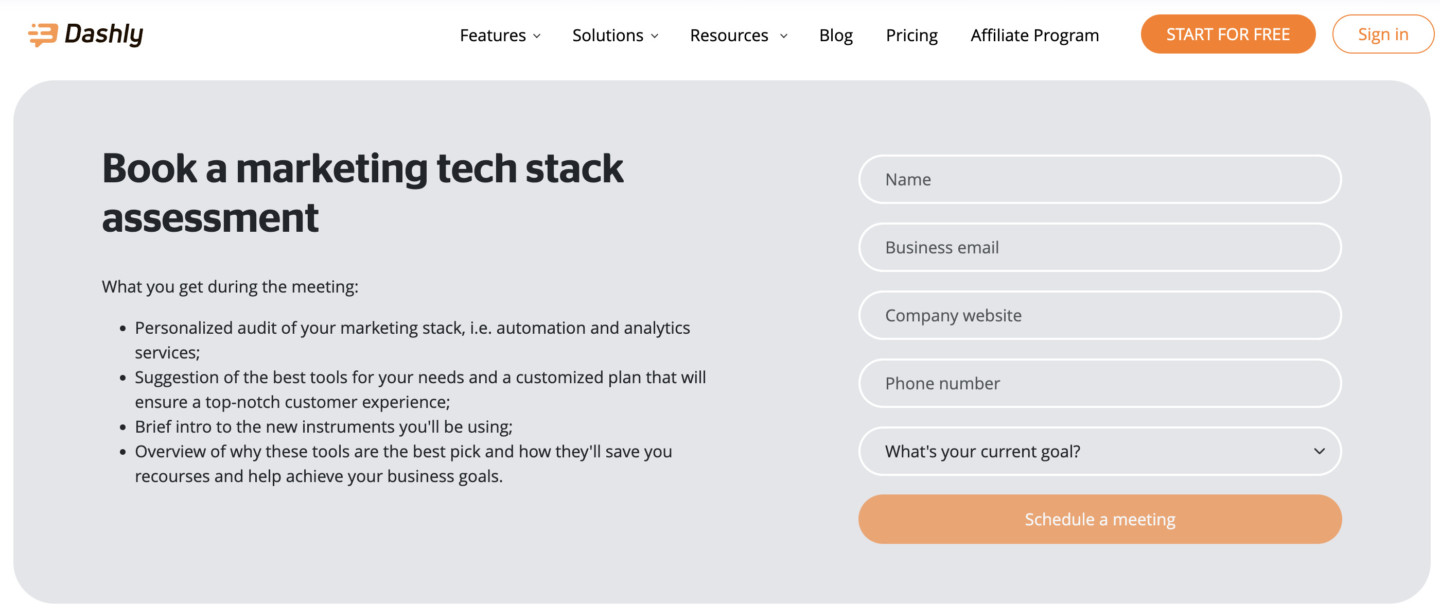
We pointed out what to expect during the meeting and who will benefit from it. Personalization is the key!
- Chatbots: A chatbot can interact with visitors in real-time, promoting your special offer and collecting email addresses in a conversational manner. This can make the process more engaging and personal.
Remember, the goal of address capture is not just to amass email addresses but to build relationships with potential customers. Special offers can do just that, providing value to your customers while helping to grow your email list.
Webinars and online courses to collect email
Here’s another curious tactic hailed as one of the best ways to collect addresses. It will require more work, though. Webinars and educational content.
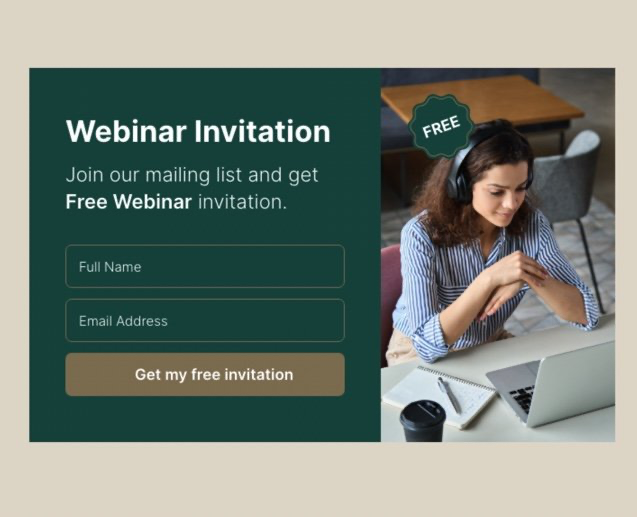
In the age of digital learning, webinars and other forms of educational content have become a popular tool for businesses. Not only do they provide immense value to your audience, but they also serve as an effective strategy for how to capture email addresses from website visitors.
So, why are webinars so effective? The answer lies in their inherent value proposition.
By offering your website visitors high-quality, valuable educational content for free (or at a low cost), you give them a compelling reason to share their contact information with you. When people see that they can gain substantial knowledge from your webinars, they’ll be more than willing to exchange their email address for the opportunity. It’s a win-win situation!
Moreover, webinars offer an excellent opportunity for collaboration.
Partnering with other companies to host webinars can drastically boost your visibility and credibility. You’ll benefit from their audience while offering them value from your expertise, potentially gaining even more email addresses in the process.
Promoting your webinars effectively is crucial to driving registration. Here’s how you can do it:
Chatbots
Use chatbots to engage with your website visitors in real-time. The chatbot can inform visitors about the upcoming webinar and deal with FAQs, collecting their email addresses in the process.
Pop-ups
A well-designed pop-up can go a long way. You can use them to promote the webinar when users land on your website or are about to leave (using exit-intent technology). Make sure the pop-up is attractive and contains clear, compelling information about the webinar.
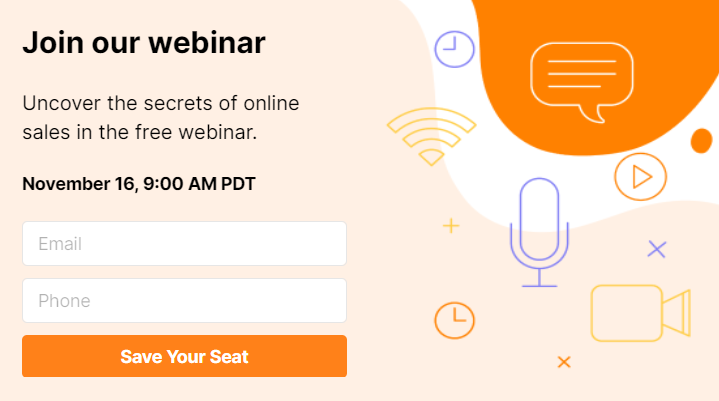
Email Campaigns
Shoot up a dedicated email campaign to your existing subscribers informing them about the webinar. Remember to include a powerful call-to-action to encourage registrations. Email campaigns are also a great tool to nurture leads after your online event.
Incorporating webinars and educational content into your marketing strategy offers a multi-faceted advantage. Not only will you collect valuable contact information, but you’ll also establish yourself as a thought leader in your industry, build lasting relationships with your audience, and potentially attract new prospects.
So, if you’re wondering how to collect contact information, look no further than the power of webinars!
But don’t leave your webinar visitors hanging, nurture them with valuable content in emails, or provide a seamless journey with a chatbot. We have a chatbot scenario that helps you work with traffic with certain UTM parameters.
Product demos and assessment for collecting emails
At last, let’s explore product demos and free assessments, advanced strategies that are part of the email capture best practices.
Product demos and free assessments are highly effective because they cater to leads who are not just casually browsing, but are genuinely interested in your product and ready to take the next step of their buyer’s journey.
These leads are looking to solve a specific problem or achieve a particular goal, and your product could be the solution they need. Offering a product demo or a free assessment could be just the push they need to convert into a customer.
But mind that for a product demo, you need more than just an email address. You’ll need to gather additional information like their website address, the task they want to resolve, or the goal they aim to achieve.
This information enables you to customize the demo to their specific needs, showcasing how your product is the perfect solution for them. This personalization creates a stronger connection and makes the prospect more likely to convert.
So, how can you offer a product demo or assessment to your website visitors? Let’s consider a few ways.
Product Pages
Create a dedicated landing page for your product demo or assessment. Make sure the landing page is compelling and provides all the necessary information about what they can expect from the demo. Don’t forget a strong call-to-action prompting them to sign up with their email and other necessary information.
Dashly’s demo page includes an interactive quiz to find out as much info about a lead as possible. But you can also find short videos from our team where they introduce you to the platform and explain what to expect from the demo.
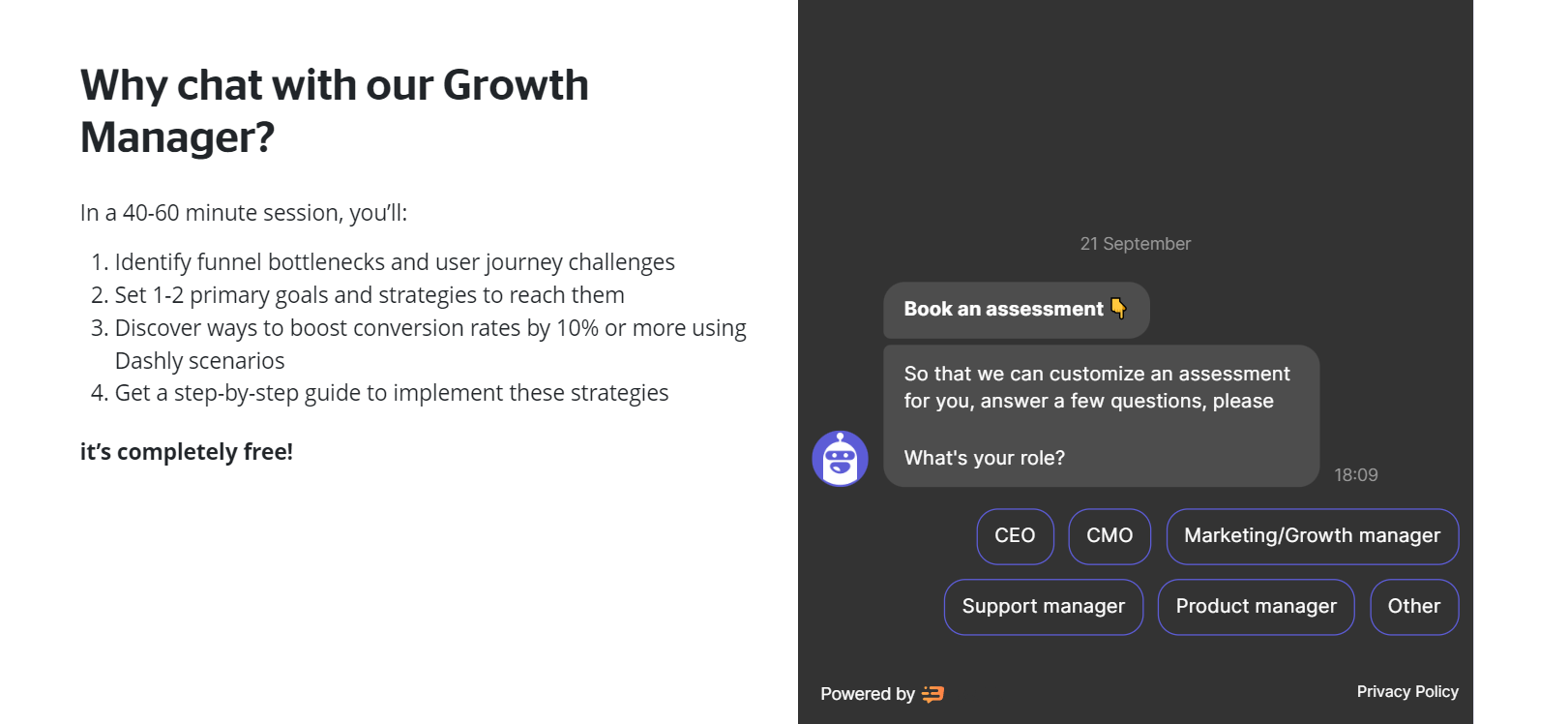
We opt for a person-to-person communication. And this way, you get to know our team even before a live meeting.
Chatbots
An interactive chatbot can engage your website visitors, answer any preliminary questions they might have, and guide them to sign up for a demo or assessment. This method makes the process feel more personal and interactive.
Direct Contact Forms
Simple, straightforward, and efficient. A contact form that visitors can fill out to request a demo or assessment is a classic but effective method. Make sure the form is easy to find and fill out to encourage more sign-ups.
Some other tools
Pop-ups
A strategically placed pop-up can catch the attention of interested prospects. You can use exit-intent technology to show the pop-up just as they’re about to leave, offering one last opportunity to sign up for the demo.
Email Campaigns
If you have an existing email list, use it! Send out an email campaign promoting the demo or free assessment, and you may find many of your existing subscribers are ready to take the next step.
Product demos and free assessments not just help you collect email addresses on your website, they also give your prospects a taste of what you have to offer, making them more likely to become paying customers.
Remember, the key to successfully capturing emails on your website is providing value, building trust, and creating a seamless experience for your visitors.
The bottom line
It’s time to wrap up our journey through the labyrinth of lead generation.
Collecting emails is an art and a science, requiring a dose of creativity, a splash of experimentation, and a pinch of persistence.
The best way to collect email addresses may differ from business to business, audience to audience. However, the strategies we’ve explored in this article — lead magnets, webinars and educational content, product demos, content updates subscriptions, and special offers — provide a strong foundation to build upon.
Whether your audience loves the direct approach of classic lead forms, the conversational charm of chatbots, or the last-minute persuasion of exit-intent pop-ups, there’s a strategy out there for you. Remember, the best online way to collect email is the one that resonates most with your audience and aligns with your brand values.
If you’re ready to turn your website into a lead-generation powerhouse, consider using Dashly’s suite of tools. We offer a variety of solutions designed to help you effectively collect email leads, and we’d be more than happy to help set up this process on your website. Your journey to mastering email collection begins here.
Happy lead hunting!
FAQ
What is the best way to collect emails?
The best way to collect emails can vary depending on your business and audience. However, some effective strategies include using lead magnets, offering webinars, giving product demos, setting up subscription for content updates, and providing special offers. These strategies offer value to the customer in exchange for their email, making them more likely to share their contact information. Also, using tools like opt-in forms, chatbots, and pop-ups can aid in the process of collecting emails.
Should I buy email lists?
Buying email lists may seem like a quick way to get a large number of email addresses, but it’s generally not recommended. People on these lists haven’t given you permission to contact them, which can lead to low engagement rates and can potentially damage your brand reputation. It’s usually more effective to build your own email list using the strategies mentioned above, as this ensures that the people on your list are genuinely interested in your business and have given you consent to contact them.
What are opt-in forms?
Opt-in forms are tools used on websites to collect visitor’s information, like their email address, in exchange for something of value such as a newsletter, a free trial, or a special offer. The term “opt-in” means that the visitor has actively agreed or “opted-in” to share their information, ensuring you’re following email marketing best practices and respecting user privacy. Opt-in forms can be placed in various locations on a website, including in a pop-up, the footer, or on a dedicated landing page.
How can I make my opt-in forms more effective?
To make your opt-in forms more effective, ensure that they are easy to find and fill out. Use clear, concise language and make sure the value of opting in is clearly communicated. A/B testing different form designs and positions can also help optimize their effectiveness.
What is a lead magnet and why should I use it?
A lead magnet is a valuable offer (like an eBook, a free consultation, or a discount code) that you give to your website visitors in exchange for their contact information, usually an email address. Using lead magnets is an effective way to collect email addresses because it offers a value exchange, making visitors more likely to share their information.
Is it important to segment my email list?
Yes, segmenting your email list allows you to tailor your messaging to different sections of your audience based on their interests, behaviors, or other factors. This can lead to higher engagement rates and more successful email marketing campaigns.
What should I do with the emails once I’ve collected them?
Once you’ve collected email addresses, it’s essential to nurture these leads with regular, valuable content. This can be in the form of newsletters, exclusive offers, product updates, or other relevant information. Remember, the goal is to build a relationship with these potential customers and eventually convert them into paying customers.
Read also:
- 4-step guide on inbound lead qualification: how to qualify inbound leads on autopilot
- Choose your ideal lead nurturing platform: Top 10 software tested by experts
- How to implement user tracking on website: guide, tactics, and tools
- Acquisition funnel marketing: Grow customer conversions at each step of user journey
- Top 10 user activity monitoring tools: tracking features, price, cons and pros
- The top 15 inbound marketing tools: harness digital power and elevate your business
- Top 12 lead qualification tools to deliver your sales hot leads only
- Top 20 best website tracking tools for effective work with visitors
- Top 10 customer segmentation tools to personalize customer communications
- 10 best website personalization tools to deliver top-notch visitors experience
- 20 AI sales tools: Boost your sales strategy with revolutionary technologies
- Top 13 follow up email software to elevate your email marketing strategy
- 10 best predictive lead scoring software to boost your sales funnel
- 7 best email capture tools: features and pricing compared for 2024





